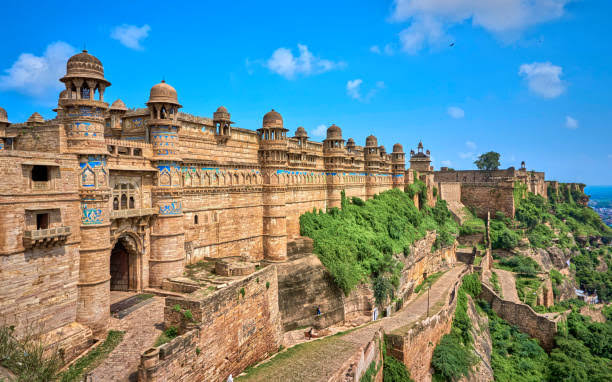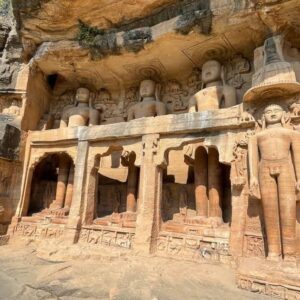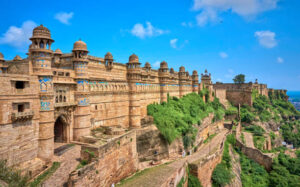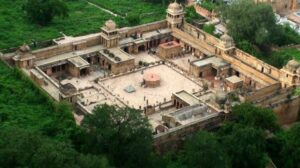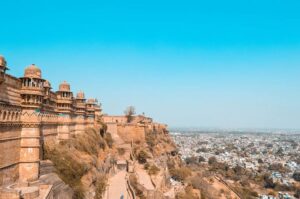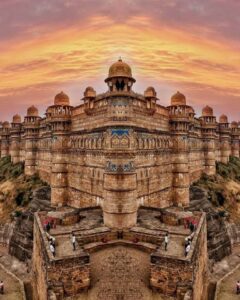Gwalior Fort – Madhya Pradesh
Gwalior Fort is today a thriving tourist destination Known as one of the most beautiful forts in the country. As soon as you step into the Gwalior Ka Qila complex, the walls of this fort grab your attention. A source of pride for the locals, the fort has become a place of worship, wonder and wonder for travellers from all over the world.
History of Gwalior Fort
According to legend, the history of Gwalior dates back to around 1000 years. Gwalior Fort has witnessed many battles in times of trouble as well as festivals in times of peace. A beautiful moment of glorious past has been taken care of, giving Gwalior an appeal to its uniqueness.
The history of Gwalior traces back to a wonderful legend in 8 AD when a leader, Suraj Sen, contracted a fatal disease. He received his healing from the hermit Gwalipa who lived on the hill where the fort stood. Gwalipa served a drink of water called Suraj Singh from the SurajKund still visible in the fort. Thankfully Suraj Singh found a city named after the saint who gave him a new lease of life. He gave another name to Suraj Sen as Suraj Pal and said that till he and his successors adopted the name PAL, they would be powerful. New Gwalior, over the centuries, was the cradle of various great dynasties. But his 84th successor changed his name and also lost his kingdom.
The Tomar dynasty came to power in Gwalior in 1938. Man Singh was a great Tomar ruler who ascended his throne in 1486. He held back the fort from the attack of Sikandar Lodi of Delhi. Ibrahim Lodi besieged this fort in 1516. After the Man Singh death his son occupied the for another one year before surrendering. After the end of the Lodi rule, the fort passed into the hands of the Mughals, who were captured by the Marathas until the year 1754. Over the next 50 years the fort saw several rulers before passing into the hands of the Sindhias. In 1857 the army revolted against the British with the intention of defying the king who was loyal to the British. It was near this time that Tatia Tope was defeated and the queen of Jhansi died in battle.
Architecture of Gwalior Fort
The fort along with its premises is very well maintained and has many historical monuments like Hindu temples and Jain temples (11 shrines, 7 Hindu temples here) along with palaces, prominent ones are Man Mandir Palace, Jahangir Mahal, Gujari Mahal (which is now archaeological turned museum), Karan Palace and Shah Jahan Mahal.
Gwalior Fort Height:
The fort is breathtaking and is built on a narrow, tall, hillock called Gopachal. The fort covers an area of about 3 square kilometers (1.2 sq mi). The fort has a height of 35 feet (11 m) and is built on massive sandstone rock.
It gives an irregular appearance due to the topography of the land on which it is built. There are two main entrances – one from the north-east and the other from the south-west. The ramparts of the fort are laid at the base of a hill connected by six bastions or bastions. It is approached from the northeast via a long access ramp. The main entrance or gateway to the fort, known as the Hathi Pul (meaning “intricately carved and rock-cut temples of the 21 Jain Tirthankaras, can be seen into the steep rock faces. One such statue, 40 feet (12 m) high, is dedicated to the 23rd Jain Tirthankara Identified as Parswanath.
Gwalior Fort Light and Sound Show
Gwalior Fort hosts a spectacular sound and light show every day in evening time. The show is very well executed and makes you feel like you are a part of the rich history of the fort and the love story of Raja Man Singh and his queen Mrignayani. The performance will take place in the amphitheater of Man Mandir.
Hotel Gwalior Regency
The hotel is located in the heart of the city and within walking distance from the railway station. Gwalior Regency provides 51 well-furnished rooms, each room consists of all modern facilities like television, telephone, AC etc. The hotel also has a multi-cuisine restaurant and also offers room service.
Gwalior Fort Timings : From Morning 08:00 AM to Evening 09:30 PM.
Sound & Light Show Timings: Hindi Show starts at 07:30 PM .The English Show starts at 08:30 PM.
Gwalior fort light and sound show ticket price : Rs. 150 for Indians & Rs. of foreigners 250 for sound & light show
Entry Fee: INR 75 pp – Indian INR 250 pp – Foreigner
Duration: About 3 – 4 hours
Gwalior Fort Location:
Gwalior Fort, Lashkar, Gwalior, Madhya Pradesh – 474008 India.
How to reach
- By road : The Gwalior fort is located at just 3.2 kms from Gwalior city. And the Gwalior city is well connected to various cities and towns of Madhya Pradesh by road, rail and air transport services.
- By train : Gwalior is, in fact, one of the rare places where narrow gauge and broad gauge railway lines operate. Hence, the city is connected by trains to various parts of India including 4 metros.
- By Air : Gwalior Airport has flights to Indore, Delhi and Bhopal. The Delhi-Jabalpur line also stops at Gwalior Airport.
Nearby Attractions to Gwalior fort
- Bateshwar Temple
- Tighra Dham
- Madhav National Park
- Bhir Singh Palace
- Koshak Mahal
FAQs about Gwalior Fort Madhya Pradesh
Q: Where is the Gwalior Fort located?
A: The Gwalior Fort is located in Gwalior city in the Indian state of Madhya Pradesh.
Q: What is the history of Gwalior Fort?
A: The Gwalior Fort has a rich history dating back to the 8th century when it was founded by the rulers of the Tomar dynasty. Over the centuries, it was ruled by different dynasties including the Mughals, Marathas, and British. It has also been the site of many battles and was considered a strategic location due to its high elevation.
Q: What are some of the notable features of Gwalior Fort?
A: The Gwalior Fort is known for its massive walls, beautiful architecture, and intricate carvings. Some of its notable features include the Man Mandir Palace, the Sas-Bahu Temple, and the Teli Ka Mandir.
Q: What is the best time to visit Gwalior Fort?
A: The best time to visit Gwalior Fort is between October and March when the weather is pleasant and cool.
Q: Is there an entry fee to visit Gwalior Fort?
A: Yes, there is an entry fee to visit Gwalior Fort. The fee varies for Indian and foreign tourists.
Q: How long does it take to explore Gwalior Fort?
A: It can take anywhere between 2-4 hours to explore Gwalior Fort depending on your level of interest in history and architecture.
Q: Is Gwalior Fort accessible for people with disabilities?
A: The Gwalior Fort has some steep climbs and uneven surfaces, which can make it challenging for people with mobility issues. However, there are some areas that are accessible by car, such as the Man Mandir Palace.
Q: Are there any nearby attractions to visit along with Gwalior Fort?
A: Yes, there are several nearby attractions that you can visit along with Gwalior Fort, such as the Jai Vilas Palace, Sun Temple, and the Scindia Museum.
Click here to know Madhya Pradesh Famous Temple
Gwalior Fort Photos:

